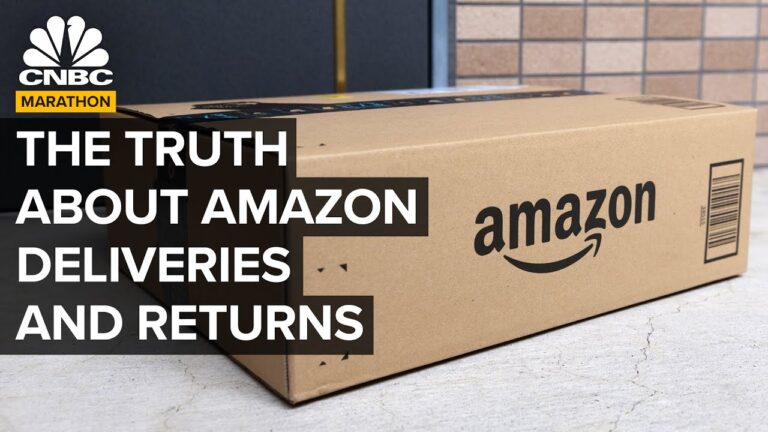Buy and Selling on Amazon has some hidden variables.
The Videos discuss those hidden elements in detail. Watch each of the Videos in order to get a complete understanding of the Shipping System and Why it is never FREE
The Topics Covered in this video are as follows:
- Amazon DSP Drivers Reveal The Challenges Of One-Day Shipping (June 2021)
- Where Online Returns Really End Up And What Amazon Is Doing About It (January 2022)
- How Liquidating Unwanted Goods Became A $644 Billion Business (February 2022)
Amazon has more than 115,000 drivers working under independent small businesses – Delivery Service Partners, or DSPs – who deliver Prime packages to doorsteps with one-day shipping. This is a large part of how Amazon delivers packages so quickly.
CNBC talked to current and former Amazon DSP drivers about the pressures of the job. From urinating in bottles to running stop signs, routes that lead drivers to run across traffic, dog bites and cameras recording inside vans at all times – some of the 115,000 DSP drivers have voiced big concerns.
But once you receive your Amazon order, if there’s any reason you are on happy, more than likely it can be returned. Sending back an online order has never been easier. It’s often free for the customer, with some retailers even allowing customers to keep the item while offering a full refund.
Amazon returns can be dropped off at Kohl’s, UPS or Whole Foods without boxing it up or even printing a label. But there’s a darker side to the record number of returns flooding warehouses after the holidays. “From all those returns, there’s now nearly 6 billion pounds of landfill waste generated a year and 16 million metric tons of carbon dioxide emissions as well,” said Tobin Moore, CEO of returns solution provider Optoro. “That’s the equivalent of the waste produced by 3.3 million Americans in a year.”
Moore says online purchases are at least three times more likely to be returned than items bought in a store. In 2021, a record $761 billion of merchandise was returned, according to estimates in a new report from the National Retail Federation. That report says 10.3% of those returns were fraudulent. Meanwhile, Amazon third-party sellers told CNBC they end up throwing away about a third of returned items. At the head of the pack, Amazon has received mounting criticism over the destruction of millions of items.
Now the e-commerce giant says it’s “working toward a goal of zero product disposal.” Last year, it launched new programs to give sellers like Clausen new options to resell returns, or send them to be auctioned off on the liquidation market. This record number of online returns has created a booming $644 billion liquidation market.
As supply chain backlogs cause shortages of new goods and Gen Z shoppers demand more sustainable retail options, pain points for one sector of retail are big business for another. The nation’s only major public liquidator, Liquidity Services, resells unclaimed mail, items left at TSA checkpoints, and outdated military vehicles.
It also refurbishes highly sought after electronics, from noise-canceling headphones to the machines that make microchips. CNBC takes you on an exclusive tour inside a Liquidity Services returns warehouse outside Dallas, Texas, where unwanted goods from Amazon and Target are stacked to the ceiling before being resold on Liquidation.com or a variety of other marketplaces.
CNBC
Free Shipping is not Free
The Ultimate Learning Video Guide on the Hidden Cost of Free Shipping and Why Free Shipping is a Myth
FedEx, UPS and Amazon make deliveries on behalf of retailers advertising “free” shipping. But, none of those packages are being shipped for free. There were over 131 billion parcels shipped worldwide in 2020, and parcel shipments are expected to double again in the next five years, possibly reaching 266 billion by 2026, according to Pitney Bowes.
The cost of shipping is becoming ever-increasing. Companies like Amazon, Walmart, Target and even Etsy benefit from economies of scale because they generate mass online sales. This puts them at an advantage to achieve bulk discount rates from carriers.
Watch the video above to learn why free shipping is a myth, what it really costs companies to send parcels around the country and how it impacts consumer sentiment. The big carriers such as FedEx, UPS and Amazon make lots of deliveries, and none of those packages are being shipped for “free.”
CNBC
Who Pays the Price for Amazon’s Free Shipping
Returns take a major toll on retailers’ bottom line and on the planet, but Amazon is taking big steps to change that. Free returns are now offered on almost all Amazon orders, with a new option to bring unboxed items in-person to any Kohl’s store.
CNBC
Additional Video Guide on How Amazon Returns Work
The majority of returned Amazon items are resold to other consumers or liquidators, returned to suppliers, or donated through a new program Amazon hopes will cut down on waste.
CNBC
What Amazon Does with Unsold Inventory
Every year, Amazon and other retailers end up with billions of pounds of excess, unsold inventory that they’re sending straight to landfills, or incinerating. Returns in the U.S. create more than 5 billion pounds of waste in landfills each year, and more than 15 million metric tons of carbon dioxide.
The problem is only growing as Amazon leads the way in bringing more shoppers online, where the rate of returns is 25%, compared to just 9% for in-store purchases. Now, the e-commerce giant and other tech companies and retailers are increasing donation efforts and using data and A.I. to cut back on the wasted inventory clogging our landfills and our planet.
CNBC


